 Irene is relatively “new” to the quilting world, but that hasn’t stopped her from taking advantage of every opportunity offered to learn and grow. An avid quilter, she sews and sews and has quite a collection of projects already under her belt.
Irene is relatively “new” to the quilting world, but that hasn’t stopped her from taking advantage of every opportunity offered to learn and grow. An avid quilter, she sews and sews and has quite a collection of projects already under her belt.
1.Very quickly, tell us where you are from and how long you have been quilting.
I’m from Guatemala, and I have been quilting for 3 years.
 2. Is quilting part of the tradition of your country? If so, tell us a little about the customs. If not, how is it you became interested and took up quilting?
2. Is quilting part of the tradition of your country? If so, tell us a little about the customs. If not, how is it you became interested and took up quilting?
I don’t think there is a quilting tradition in Guatemala. Usually whenever I mention it to people, they don’t know what I’m talking about. But I do know there are rural communities where quilts are made using local fabrics. They are exported or sold to tourists. The people who make them have learned the techniques from tourists or foreigners who have taught them so they can export their products. Personally, however, I don’t know many people who quilt.
I had always admired this craft, and knew a couple of people who had made one or two simple projects they had seen in needlework magazines, but I had never tried it myself. Then three years ago a friend invited me to join a class she was taking at the Intecap (an institute that offers different kinds of technical training). I learned there most of what I know today, plus what I have been able to read in books and via the Internet. My teacher, Silvia Pereira, has over 20 years of experience quilting, in addition to other crafts. She studied in the U.S. and knows many different quilting techniques, and constantly experiments to come up with original products, especially products that can be sold.
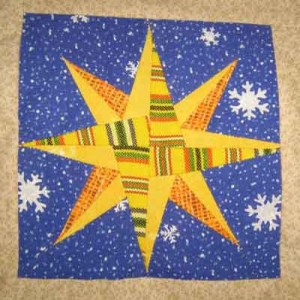 3. What fabrics do you use? Is it difficult to purchase the cotton fabrics most often used for quilting in your country? Do you buy locally? Are there fabrics you use that would be considered unusual throughout the quilting world?
3. What fabrics do you use? Is it difficult to purchase the cotton fabrics most often used for quilting in your country? Do you buy locally? Are there fabrics you use that would be considered unusual throughout the quilting world?
We mostly use imported 100% cotton fabrics. They are very expensive and there are only two or three stores that carry them, along with quilting supplies and tools (as well as for other crafts). There is also some cotton fabric made locally, but it tends to be coarse and rough. This makes it easy to iron, but difficult to quilt. The typical woven cotton fabric available is beautiful, but has to be washed well as the dyes run, and in some cases the fabrics easily fray.
Casa Decora probably carries the best and largest variety of fabrics in the capital city.
4. What do you use for batting? Once again, are you able to find this locally or do you have to order it online?
We can find felt and different types of batting (varying in quality and thickness). These are easily found in fabric and furniture stores.
5. What about other supplies? Threads, stabilizers, fusible web, etc? What are you able to purchase locally and what do you have to obtain from outside your country?
We are not able to find freezer paper, water soluble stabilizer, and other similar products. We are able to find fusible interfacing, though.
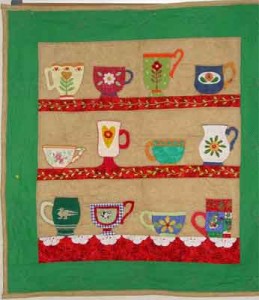 6. Do you use “modern” quilting tools, like a mat, rotary cutter and specialty rulers? Have you had to improvise and adapt tools?
6. Do you use “modern” quilting tools, like a mat, rotary cutter and specialty rulers? Have you had to improvise and adapt tools?
Yes, we do use modern tools. What can not be found easily, however, are large quilting hoops or long arm quilting machines. I think there might be a store that offers long arm quilting services, but I’m not sure about that.
7. What about other quilters? Is there a group or association that meets in your city/country? Do you plan events together?
Quilting is catching on slowly, although most people don’t seem interested (the younger generation hates sewing. I’m convinced if they could make clothes with a glue gun, they would do it!) I don’t know of any other group or association, other than those of us who have studied under Silvia at the Intecap. Our time together in class is where we were able to share ideas and lessons learned. Those of us who no longer take her classes discussed the possibility of starting to meet to be able to continue to share, but that still hasn’t happened.
8. What would you say are the biggest challenges or difficulties for a quilter in your country?
Getting more people interested in quilting. And being able to purchase supplies and tools at reasonable prices.
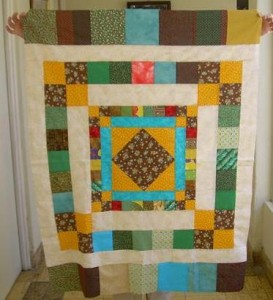 9. And what are the greatest opportunities?
9. And what are the greatest opportunities?
Since this craft is not well known, there is a great opportunity in being able to teach it to others.
10. In one short sentence, what is your quilting philosophy?
It is a great way to relax, show one’s creativity, and is therapeutic.
11. Is there anything else you would like to share that you feel is central to who you are as an “international” quilter?
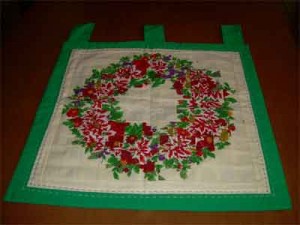 I would love to be able to share with others the emotional benefits I have experienced from learning to quilt. It has awakened my creativity, not only with relation to sewing, but to technology. Because of it I have learned to use the Internet, visiting blogs and websites, and it has allowed me to practice English more. It took me from a rather depressed state to becoming more alert and enthusiastic, satisfied with myself and with what I am doing, and looking forward to future projects. It took away my fear from starting up friendships with people from other communities and cultures.
I would love to be able to share with others the emotional benefits I have experienced from learning to quilt. It has awakened my creativity, not only with relation to sewing, but to technology. Because of it I have learned to use the Internet, visiting blogs and websites, and it has allowed me to practice English more. It took me from a rather depressed state to becoming more alert and enthusiastic, satisfied with myself and with what I am doing, and looking forward to future projects. It took away my fear from starting up friendships with people from other communities and cultures.
As to the future, I am planning on teaching others, motivating them to learn more and become involved in the international quilting community. And I would like to organize a group in my community in order to make charity quilts.
*****************************************
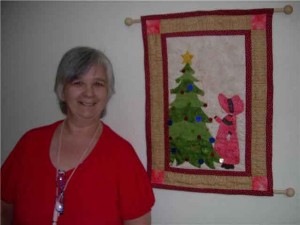 Although Irene does not mention it in her interview, here are a couple of additional tidbits I know about her:
Although Irene does not mention it in her interview, here are a couple of additional tidbits I know about her:
1. She is related to quilt artist Priscilla Bianchi, author of Caliente Quilts.
2. Not surprising, she is addicted to fabric. Quite fortunately, her family enthusiastically supports her habit. As she tells: “I always spend more than planned. So one day I decided to take my daughters with me so they would keep me from spending too much. Bad idea! They liked everything and their enthusiasm pushed me to buy more. So another day I asked my husband to go with me. I figured he certainly would stop me from buying to much. IT WAS EVEN WORSE! He kept telling me to ‘take this… and that… and look at this one. And oh, what nice Christmas fabric… you should make some tablecloths.’ And so it went on. The good thing in this case is that he paid for it all! LOL”
*****************************************
Quite unfortunately, Irene doesn’t have a blog, but she’s working on that. In the meantime, you can see some of her quilts on her Flickr account. And I’m sure she’d like to hear from you! Just leave a comment here to encourage Irene in her quilting endeavors.
 I am a self-learner. I taught myself to sew and to quilt. And I taught myself how to draw. I am learning how to dye my own fabrics and am dabbling with mixed media. I am a quilt designer and teacher, and design and publish my own line of quilt patterns. With this blog I would like to share the bits and pieces of my life.
I am a self-learner. I taught myself to sew and to quilt. And I taught myself how to draw. I am learning how to dye my own fabrics and am dabbling with mixed media. I am a quilt designer and teacher, and design and publish my own line of quilt patterns. With this blog I would like to share the bits and pieces of my life.
3 Comments
Oh Irene and Angie, Thank you for this delightful interview.
Irene, I send you all my best wishes for your continued growth as a quilter and that teaching opportunities will open up for you.
Thanks you so much for sharing!
🙂
Thanks, Angie. It’s very stimulating to see my interview in your blog, and fun too, to read my fabric-buying anecdote shared with everyone, that’s the way I’d like to be known: a well-humored person, almost always with a smile in my face, and laughing about that simple things of everyday. My life is fullfilled with love! and more now, whith the friendship of you and your readers around the world. @Valentina: thanks, I never imagined to have a friend as far as Cyprus!
May I only correct one thing? My family name is Pratdesaba, without the extra “s”.
Hi Irene,
I am glad to see your beautiful quilts. Those yo-yo angels are such a great idea and the origami quilt is fabulous!
It is very funny the story about the fabric “addiction” in your family, we are so lucky having such supportive husbands!
Good luck with your teaching plans, I know from Angie that this is a sure way to make new quilting friends.